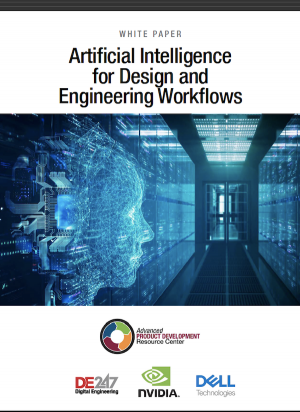
BlankAI, one of many technologies that comprise Autodesk AI, will debut in the automotive design studio, enabling designers to quickly generate concepts using AI functions. Image courtesy of Autodesk.
December 8, 2023
The annual Autodesk user conference, Autodesk University, was back in full swing at its usual site, The Venetian in Las Vegas, Nevada, in November. On Day One, product designers, movie makers, game makers, and civil engineers hurried past the flashing slot machines and roulette tables and streamed into the Venetian Ballroom to hear Autodesk CEO Andrew Anagnost’s keynote. His message might be summed up by the following line. “For better or worse, AI has arrived,” said Anagnost. “We've been working to get you excited about AI for years. But now we're moving from talking about it to actually changing your businesses,” added Anagnost.
The change began with a change in Autodesk’s product lineup. As Anagnost spoke, Autodesk’s new website for Autodesk AI went live. The company writes, “Autodesk AI is available to augment creative problem-solving and exploration, automate tedious and repetitive work, and give individuals and teams access to powerful analysis tools to inform decision-making.”
Anagnost said, “AI is the future of design and make, and Autodesk is pioneering this transition. We sit at the junction of many of the most creative and impactful industries in the world. We’ll continue to invest in AI because of its transformational potential to drive better outcomes for our customers’ businesses and the world.”
Automate the Mundane, the Routine
By now, many have heard, seen, and even used Autodesk Generative Design, part of Autodesk Fusion. Autodesk AI may be viewed as a more powerful, more comprehensive, cross-industry approach to AI, bolstered partially by Autodesk’s recent acquisition of BlankAI, among many other things.
In Day Two’s keynote, Jeff Kinder, Autodesk Executive VP of Product Development and Manufacturing, said, “Debuting in our automotive design studio next year, BlankAI will allow you to pull from your historical library of design work, then use it to rapidly generate new concepts that build on your existing design style.”
According to Autodesk, BlankAI enables product designers to:
- easily generate and edit proportional 3D models
- customize their development process with semantic control
- incorporate their brands’ design DNA
- dynamically navigate the data in their design portfolio
In addition, Kinder also said, “By the end of the year, we will launch Automated Drawings in Fusion to translate 3D models into fully dimensioned drawings with the click of a button.”
Autodesk recently acquired FlexSim, which develops factory logistics and analysis software. Kinder gave sneak peeks of it as part of the Autodesk Portfolio. “FlexSim powers a key link between factory design data and operational data. It helps with everything from planning and designing to building and operating a digital factory. Autodesk brings together strengths in factory operations, building design, and construction solutions,” he said.
Autodesk also highlighted its partnership with Cadence, a leading electronic system design company, to streamline smart product development by improving collaboration across electronics and mechanical design teams.
Kinder said, “Our integration as part of the Autodesk Platform ecosystem connects Cadence’s PCB design capabilities directly to Fusion, enabling data to flow in both directions.”
AI Speeds Up Toolpath Generation
During the keynote, Kinder highlighted CloudNC, an Autodesk partner that develops CNC automation software. “CloudNC add-in for AI-powered CNC toolpath automation. CloudNC sees customers reduce tool programming times by up to 80%,” said Kinder.
Theo Saville, CEO of CloudNC, said, “As a CNC programmer, you will be given a great starting point far more quickly. You're not going to need to create everything from scratch every single time; you're going to start at 80-90% of the way, and you're going to make tweaks, make adjustments.”
Training Using Proprietary Data
In an excerpt from the upcoming Autodesk State of Design & Make Spotlight on AI report, Autodesk states, “66% of industry leaders predict that AI will be an integral part of their business within 2-3 years.”
Many AI-based design and simulation software makers are looking at giving users a way to further refine the algorithms using proprietary data. Autodesk is also heading in the same direction, though the exact mechanism to facilitate it, remains unclear.
In his Q&A with the industry press, Anagnost said, “At some point, as some of these capabilities get to a level of automation, we may actually license a model to a particular customer and they can train and improve that model on top of their capabilities. That's the business model that Microsoft is using right now for some of their tools. I think it's a very robust model.”
Hardware for AI Workloads
The use of AI/ML to train and refine algorithms can be data- and compute-intensive. At AU, partner hardware makers like Dell showcased their latest hardware targeting such workloads.
The latest Dell Precision 7960 Tower, on display at AU, is the idea platform for AI development as it offers a very scalable architecture starting at 12 and going up to 56 cores on the 4th Generation Xeon W CPUs with Advanced Matrix Extensions for AI acceleration. The Precision 7960 Tower with the expanded chassis, as compared to the previous generation Precision 7920 Tower, can support from 1 to 4 double-wide GPUs, including the NVIDIA RTX 6000 Ada generation for maximum GPU compute performance. Fourth-generation Tensor Cores provide faster AI compute performance, delivering more than 2X the performance of the previous generation GPUs.
According to Scott Hamilton, Senior Industry Strategist, Dell, “The extreme configurability provides ideal options for high-end Visualization, like VRED and Omniverse use cases, and Artificial Intelligence development and inferencing applications.”
For more, watch the DE video report from the AU Exhibit Hall here.
More Dell Coverage

More NVIDIA Coverage
Subscribe to our FREE magazine, FREE email newsletters or both!








